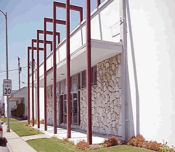Jun
3
California Firm Agrees to $31,000 Fine for Deemed Export Violation
 Posted by Clif Burns at 9:08 pm on June 3, 2008
Posted by Clif Burns at 9:08 pm on June 3, 2008
 Category: Deemed Exports
Category: Deemed Exports
 ABOVE: TFC Manufacturing
ABOVE: TFC Manufacturing
California-based machining facility, TFC Manufacturing, recently agreed to pay $31,500 in fines to settle “deemed export” allegations made by the Bureau of Industry and Security. According to BIS’s charging letter, TFC disclosed “technology for the production of aircraft parts” to an Iranian national in the United States. According to BIS, the technology was classified under ECCN 9E991.
Those familiar with the logic of the Commerce Control List, will immediately note that the ECCN involved is one of the xx99x ECCNs. These are typically broad catch-all categories of items that are called, in BIS-speak, “n.e.s.,” or “not elsewhere specified.” (What additional costs would be incurred by BIS to eliminate “n.e.s.” as an acronym in the Commerce Control List and simply print out “not elsewhere specified”? Certainly not enough to justify this ridiculous acronym.) And these xx99x n.e.s items are generally controlled only for anti-terrorism (“AT”) reasons, meaning that licenses are only required to the AT countries such as Iran. In this case ECCN 9E991 refers to technology relating to ECCN 9A991 which simply covers aircraft parts “n.e.s.”
The President of TFC that signed the Settlement Agreement had an Iranian surname and it is likely, if not certain, that the employee involved was an Iranian refugee and not someone likely to transfer aircraft part technology to the government of Iran. Nevertheless, an “deemed export” of controlled technology to the Iranian refugee is equivalent, under BIS rules, to an export directly to Iran. The company was subject to the new $250,000 maximum penalty in this case, and so it is reasonable to assume that the $31,000 fine imposed on TFC was an implicit recognition that the violation was a technical violation that did not greatly impinge on the security interests of the United States.
 Permalink
Permalink
Copyright © 2008 Clif Burns. All Rights Reserved.
(No republication, syndication or use permitted without my consent.)
7 Comments:

When will someone facing such a fine have the courage or knowledge, or both, to argue that the proclaimed license requirements are ultra vires? The EAA explicitly states that an export license for technology transfers within the U.S. is required only when the “exporter” has an a priori knowledge (or arguably merely even a reason to believe) that the technology will be exported by that foreign national to his/her home country. Instead we’ve tacitly allowed the Department of Commerce to enter the business of granting work visas – an extension of authority beyond any Congressional mandate.

To the extent the “release” of technology consists of simply making information available to a person otherwise lawfully in this country, there are also First Admentment problems.

Wait a minute. If this iranian national is a permanent resident and lawfully allowed to work in the US, he is exempt under 734.2(b)(ii).

The employee was probably not a permanent resident or a protected individual under section 734.2(b)(ii). You can still work in the U.S. without fitting in those categories. And not all refugees fit within the definition of “protected individuals.”

To Jairo: not only that, but 8 USC 1324b(a)(3) includes aliens “admitted as a refugee” or “granted asylum.” Clif’s post describes the guy as a “refugee,” but he very well might have entered on a different visa and then applied for asylum (but not yet been granted it).

Cliff…to easy again…
Cliff wrote…”in BIS-speak, “n.e.s.,†or “not elsewhere specified.†(What additional costs would be incurred by BIS to eliminate “n.e.s.†as an acronym in the Commerce Control List and simply print out “not elsewhere specifiedâ€?”
N.E.S is not an acronym, it is an abbreviation! DUH!

Cliff…to easy again…
…
N.E.S is not an acronym, it is an abbreviation! DUH!
Our BIS troll returns re-christened as “hodgepodge,” but his/her IP address from Newark is a distinctive signature.
Sadly, hodgepodge’s erudition on this point is a bluff. Let’s see what Merriam-Webster has to say about this point.
Merriam-Webster, Inc. Merriam-Webster’s Dictionary of English Usage, 1994. ISBN 0-877-79132-5. pp. 21–2:
acronyms A number of commentators (as Copperud 1970, Janis 1984, Howard 1984) believe that acronyms can be differentiated from other abbreviations in being pronounceable as words. Dictionaries, however, do not make this distinction because writers in general do not:
“The powder metallurgy industry has officially adopted the acronym ‘P/M Parts'” —Precision Metal Molding, January 1966.
“Users of the term acronym make no distinction between those which are pronounced as words … and those which are pronounced as a series of characters” —Jean Praninskas, Trade Name Creation, 1968.
“It is not J.C.B.’s fault that its name, let alone its acronym, is not a household word among European scholars” —Times Literary Supp. 5 Feb. 1970.
“… the confusion in the Pentagon about abbreviations and acronyms—words formed from the first letters of other words” —Bernard Weinraub., N.Y. Times, 11 Dec. 1978.
Pyles & Algeo 1970 divide acronyms into “initialisms,” which consists of initial letters pronounced with the letter names, and “word acronyms,” which are pronounced as words. Initialism, an older word than acronym, seems to be too little known to the general public to serve as the customary term standing in contrast with acronym in a narrow sense.
And, btw, “hodgepodge,” if you’re going to get snarky about usage you might learn the difference between “to” and “too.”

 Permalink
Permalink

 Posted by
Posted by  Category:
Category: 

